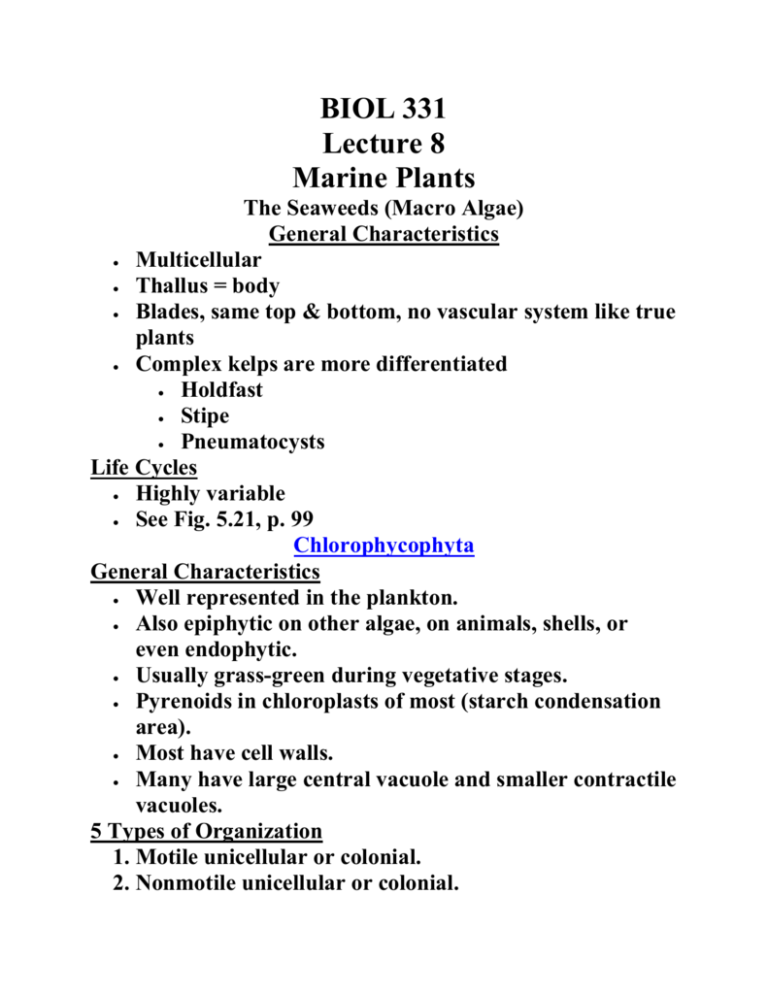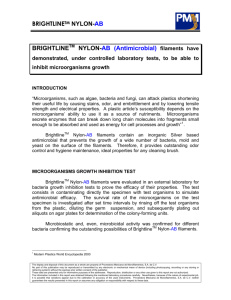Plant Lecture
advertisement

BIOL 331 Lecture 8 Marine Plants The Seaweeds (Macro Algae) General Characteristics Multicellular Thallus = body Blades, same top & bottom, no vascular system like true plants Complex kelps are more differentiated Holdfast Stipe Pneumatocysts Life Cycles Highly variable See Fig. 5.21, p. 99 Chlorophycophyta General Characteristics Well represented in the plankton. Also epiphytic on other algae, on animals, shells, or even endophytic. Usually grass-green during vegetative stages. Pyrenoids in chloroplasts of most (starch condensation area). Most have cell walls. Many have large central vacuole and smaller contractile vacuoles. 5 Types of Organization 1. Motile unicellular or colonial. 2. Nonmotile unicellular or colonial. 3. Filamentous. 4. Membranous. 5. Coenocytic and tubular. Cladophora (Gr. klados, Branch + Gr. phoros, bearer) Filamentous, zoospore producing. Free floating or attached to rocks by rhizoidal branches. Growth of branching filaments is localized near the apices of the filaments. Frothy cytoplasm with numerous nuclei (mitosis and cytokinesis are totally independent). Life Cycle (like Fig. 5.21 a) Both sexual and asexual reproduction occurs. Both diploid and haploid filaments occur, indistinguishable. Diploids undergo meiosis to produce haploid zoospores with 4 flagella. Zoospores with 4 flagella develop into haploid filaments. Haploid filaments only produce zoospores with 2 flagella. Biflagellate isogametes also produced by similar method. Referred to as a diplobiontic life cycle (others with only one free-living form are haplobiontic). Cladophora is also isomorphic because alternating generations look the same (heteromorphic when different). Ulva (L. marsh plant) Membranous, 2 cells thick. Held to substrate by multicellular holdfast with rhizoidal protuberances (cells often multinucleate). Cells of main body uninucleate. Life-cycle similar to Cladophora but dioecious (male & female gametophytes). Parthenogenesis (egg becomes zygote without fertilization) also occurs. Codium (Gr. a fleece), Dead Man’s Fingers Branched, rope-like plants, tubes bear vesicular branches with gametangia at the bases. Rapidly colonizes new areas and is highly destructive of oysters, clams, and scallops. Life Cycle (like Fig. 5.21 c) Appears to be haplobiontic with the diploid stage visible. Dioecious and produce anisogametes. Zygotes develop into small plants, but a new generation of sexually mature plants has not been grown in culture so life cycle is incomplete. Phaeophycophyta General Characteristics Approx. 250 genera, 1500 species. Flourish in colder waters on rocky coasts, many attached in shallow water. Brownish shades of the plants due to the abundance of fucoxanthin in the plastids. No starch in cells, excess carbohydrates stored as laminarin, mannitol, or fat droplets. Large nuclei. Motile cells are laterally or sublaterally biflagellate. Plant body can be highly differentiated. Referred to variously as rockweeds, wracks or kelps. Ectocarpus (Gr. ektos, outside + karpos, fruit) Branching, filamentous, growing on stones, shells, or epiphytically on larger algae. Life cycle much like that of Cladophora. Female gametes settle to the bottom and attract males with ectocarpene. Life cycle may vary from area to area and haploid (from parthenogenesis), diploid, and tetraploid sporophytes are known to occur. Laminaria (L. blade) Attached to rocks that are submerged even at extreme low tide. Plant consists of a branching holdfast, a stipe and expanded blade. Growth occurs at junction with stipe (intercalary) and thus oldest part of blade is at apex. Anatomy is Complex Only superficial cells photosynthetic. Central part of blade composed of long, colorless, filamentous cells making up the medulla. Some central cells (trumpet hyphae) have flaring ends and function as sieve elements. Life Cycle Similar to Ulva (Fig. 5.21 a). Superficial cells of blade elongate and develop as unilocular sporangia which occur in extensive groups called sori. Sex chromosomes control the sex of gametophytes. Fucus (L. fucus from Gr. phycos, seaweed) Attached to rocks in the intertidal zone where they are exposed at low tide. Anatomy complex. Derivatives of apical cells differentiate into epidermis, cortex, and a central region of branching filaments. Production of reproductive cells is localized at the tips of the branches in fertile areas called receptacles. Receptacles become enlarged due to excretion of large amounts of hydrophilic compounds internally. The receptacles bear scattered, pustule-like cavities called conceptacles. Tufts of colorless filaments protrude from osteoles in conceptacles. Life Cycle (like Fig 5.21 c) Conceptacles bear egg and sperm. Dioecious or monoecious depending on species. Eggs attract sperm with fucoserratene. Liberation of gametes is timed carefully with tides, drying action of low tide causes extrusion of oogonia and antheridia, tide rising causes release of gametes. Other Common Genera Nereocystis (Gr. nereus, god of the sea + kystis, bladder). Single stipe terminates in pneumatocyst with numerous blades attached. Postelsia (After A. Postels, a German naturalist). Macrocystis (Gr. macro, large + kystis, bladder) Egregia (L. egregius, remarkable) Division Rhodophycophyta General Characteristics Mostly marine. Phycoerythrin usually masks chl a & d. Stores carbohydrates as Floridean starch (~15 glucose subunits). Vegetative cells either uninucleate or multinucleate. Most are filamentous, membranous, or foliate. Most are diplobiontic with meiosis occurring in the sporangia of a special alternate called a tetrasporophyte. Porphyra (Gr., purple) General Characteristics Ulva-like plant body, 1-2 cells thick with thick colloidal walls. Uninucleate cells, 1-2 stellate chloroplasts. Growth is generalized. Life cycle (like Fig. 5.21 d) The laminar form is haploid and produces spermatia and carpospores. Carpospores are diploid and may represent zygotic products. Carpospores develop into the Conchocelis phase. Conchospores produced by Conchocelis phase and become Porphyra stage. Porphyra phase can develop directly from filaments of the Conchocelis phase. Both the Porphyra phase and the Conchocelis phase are known to perrenate. Polysiphonia (Gr. polys, many + Gr. siphon, tube) General Characteristics Epiphytic on larger algae and other plants or rocks. Branching, filamentous. Growth strictly apical. Life Cycle (like Fig. 5.21 d) Diplobiontic with dioecious gametophytes. Gametophyte and tetrasporophyte very similar in appearance. spermatium and egg fuse to form zygote while still on the gametophyte. zygote develops into a carposporophyte which forms carpospores. Carpospores develop into a free-living tetrasporophyte. Tetrasporophyte releases tetraspores that develop into gametophytes. Other Common Genera Gigartina (Gr. gigarton, a grape stone) Corallina Iridea (L. iris, stem: irid-, rainbow) Halosaccion (Gr. hals, the sea + sakkos, sack) Flowering Plants (Division Anthophyta) The "seagrasses" True plants with roots, stems, leaves and flowers. Not really grasses. Pollinated and seed dispersal by water movements Zostera (eelgrass) is found in protected areas. Phyllospadix (surf grass) is found in exposed, rocky areas. Halophytes Salt tolerant plants often found in salt marshes. Cannot survive total submergence. Spartina (cord grass) Salicornia (pickle weed) b331syll.htmb331syll.htmBack to the BIOL 331 Syllabus






